C. Answers to selected questions
Disclaimer
Note that there may be more than one correct way to solve many of the questions in this textbook. If the steps used in a solution presented below differs from the method that you used, it does not necessarily mean that your method is incorrect. On the other hand, just because you may come to the same solution as the textbook does not necessarily mean that your method was correct. Have a discussion with your instructor if you’re unsure if your approach is correct.
Chapter 1
Conceptual comprehension
- A scientific theory is an explanation of how the universe works. It is supported by multiple, repeated evidence. (In other words, it is not merely an untested idea.) On the other hand, a scientific law is a statement describing the relationship between observed or measured quantities. Most of the time, a scientific law is expressed as one or more equations.
Chapter 2
Numerical analysis
- The scenario is depicted in Figure C.1.
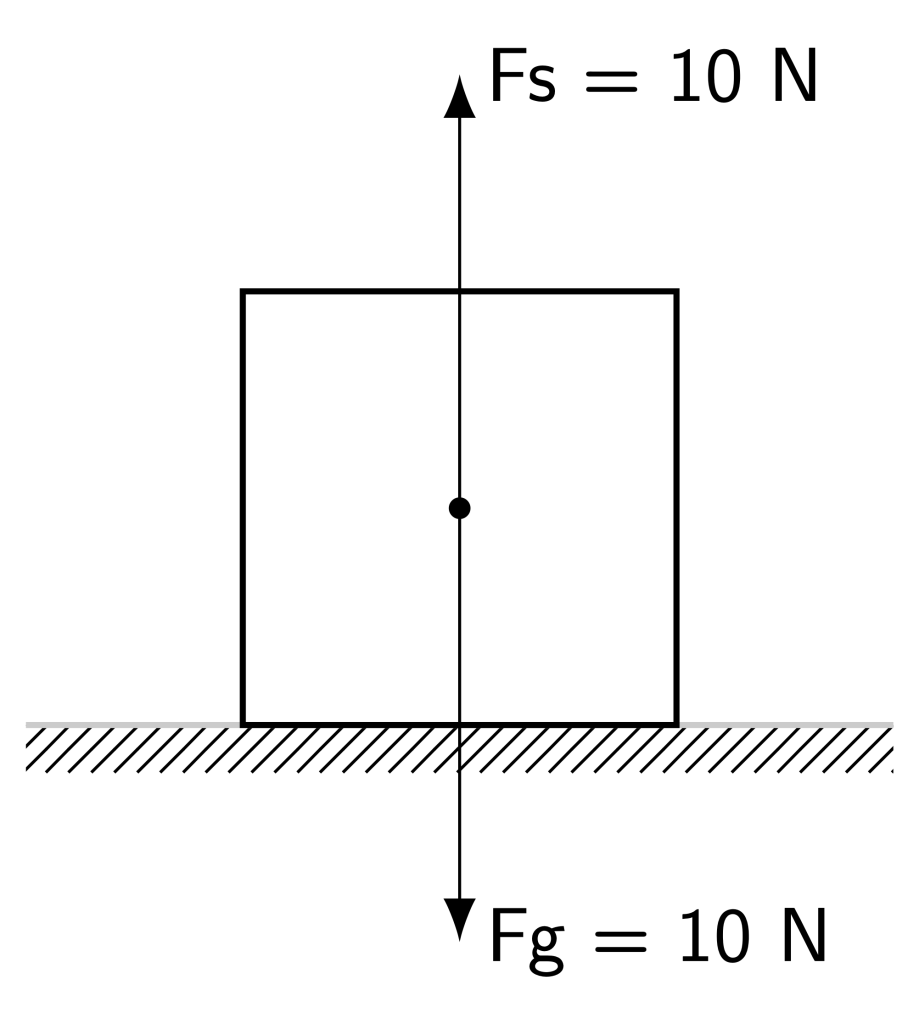
The magnitude of the net force acting on the box is

Because the net force acting on the box is 0 N, the box is in mechanical equilibrium.
- The scenario is depicted in Figure C.2.

The magnitude of the net force acting on the boat is

Because the net force acting in the boat is not equal to zero, the boat is not in mechanical equilibrium.
- The scenario is depicted in Figure C.3.

The overall horizontal component of the force acting on the block is
![]()
The overall vertical component of the force acting on the block is
![]()
The magnitude of the net force is
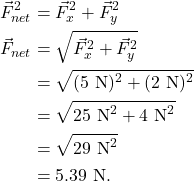
- The scenario is depicted in Figure C.4. (Note that the force arrows are not to scale with each other in this figure.)
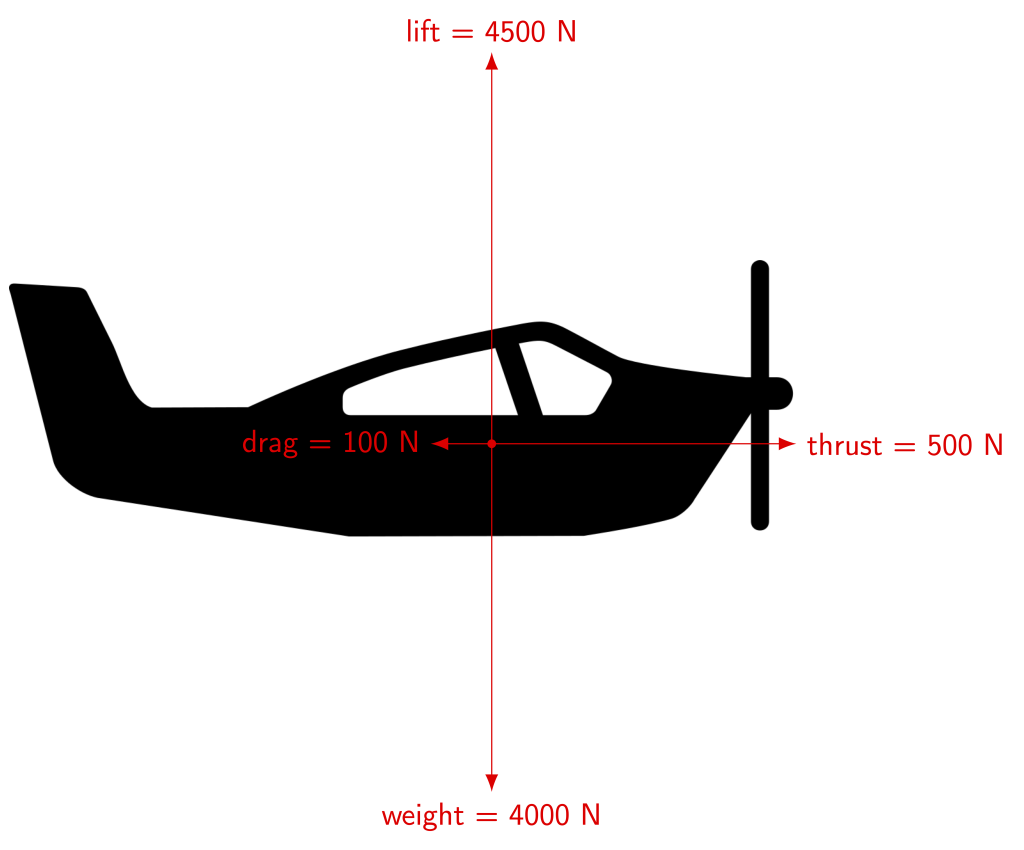
The overall horizontal component of the force acting on the airplane is
![]()
The overall vertical component of the force acting on the block is
![]()
The magnitude of the net force is
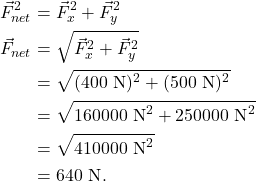
Chapter 3
Conceptual comprehension
- Draw out the piece of string in a straight line from the starting position to the ending position. Cut the string to that length. Then, using the distance scale on the map, determine how the length of the string relates to the straight-line distance in miles or kilometers. To determine direction, note the overall direction that the car traveled in relation to the compass rose.
Numerical analysis
- The scenario is depicted in Figure C.5.

Path is the overall distance traveled by the person, which is
![]()
Displacement is the change in position of the person, which is

- The scenario is depicted in Figure C.6.

Path is the overall distance traveled by the elevator, which is
![]()
Displacement is the change in position of the elevator, which is

- The scenario is depicted in Figure C.7.

Path is the overall distance traveled by the skier, which is
![]()
Displacement is the change in position of the skier, which is

- Path is the overall distance traveled by the boat, which is
![]()
Displacement is the change in position of the boat, which is 0 km, as the boat’s final location is the same as its initial location.
- Average speed is equal to distance (path) divided by time.

Velocity includes direction. The average velocity of the car is 27.8 m/s west.
- The path the bird travels as it flies north is 2 km. The path the bird travels as it flies south is 2 km. The overall path of the bird is 4 km. The overall displacement of the bird is 0 km (initial and final locations are the same).
- The instantaneous speed of the bird as it flies north is
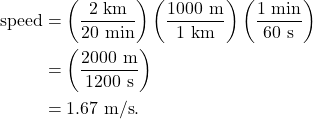
-
- The instantaneous speed of the bird as it flies south is
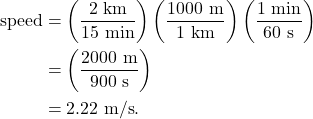
-
- The average speed of the bird over its entire journey is
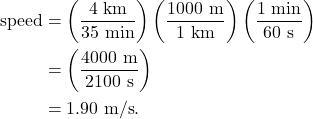
-
- The average velocity for the bird over its entire journey is 0 m/s, as the overall displacement of the bird is 0 m.
- The position vs. time graph is depicted in Figure C.8.
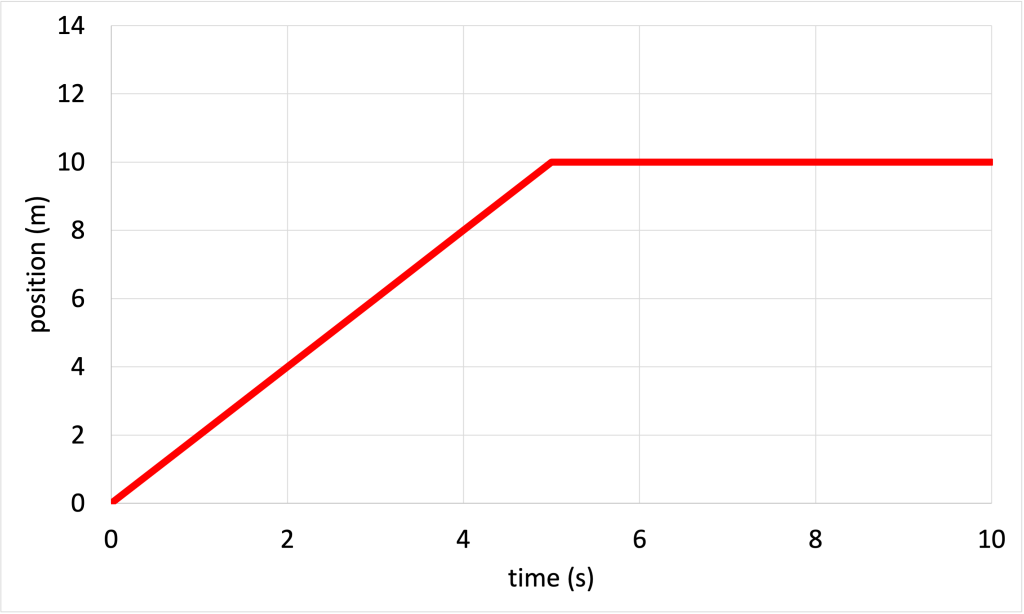
The velocity vs. time graph is depicted in Figure C.9.
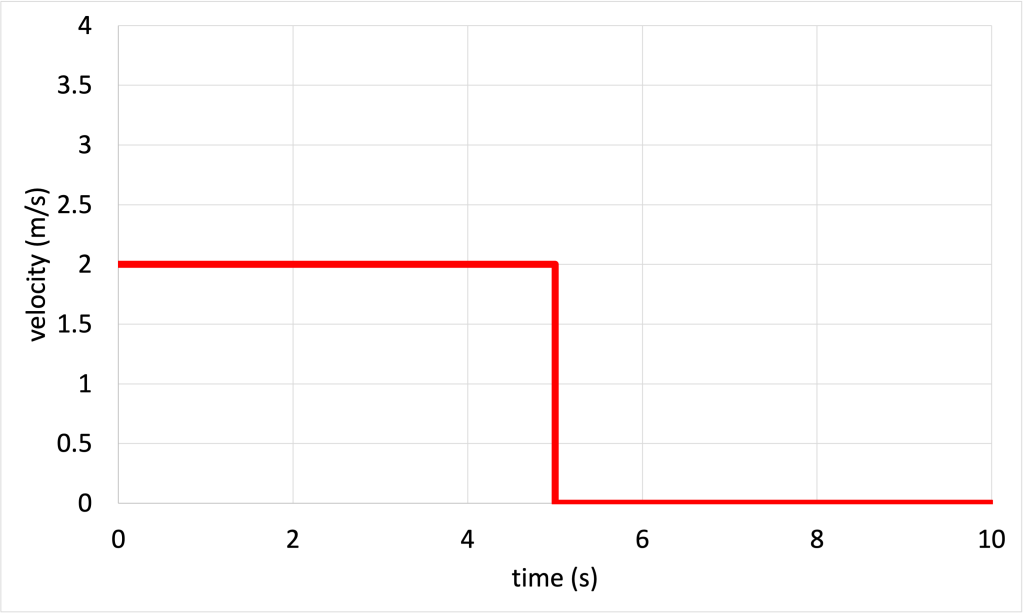
- The position vs. time graph is depicted in Figure C.10.
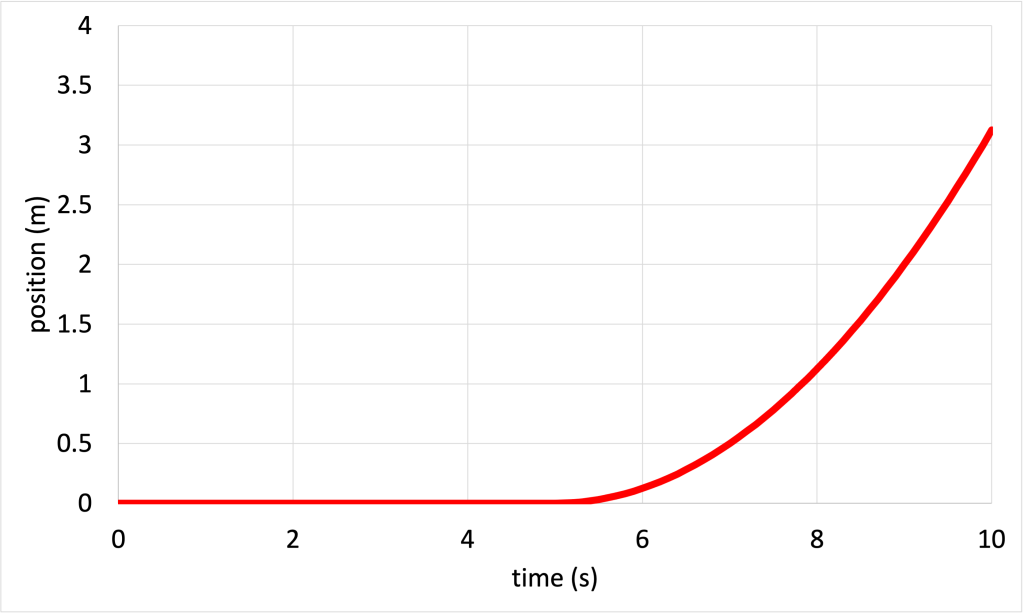
The velocity vs. time graph is depicted in Figure C.11.

- The position vs. time graph is depicted in Figure C.12.
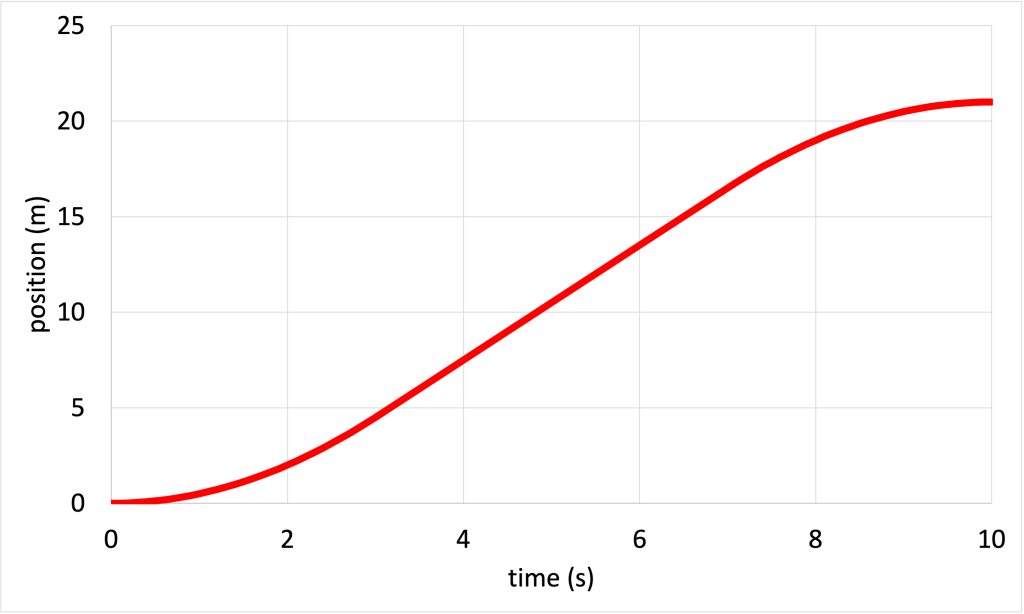
The velocity vs. time graph is depicted in Figure C.13.
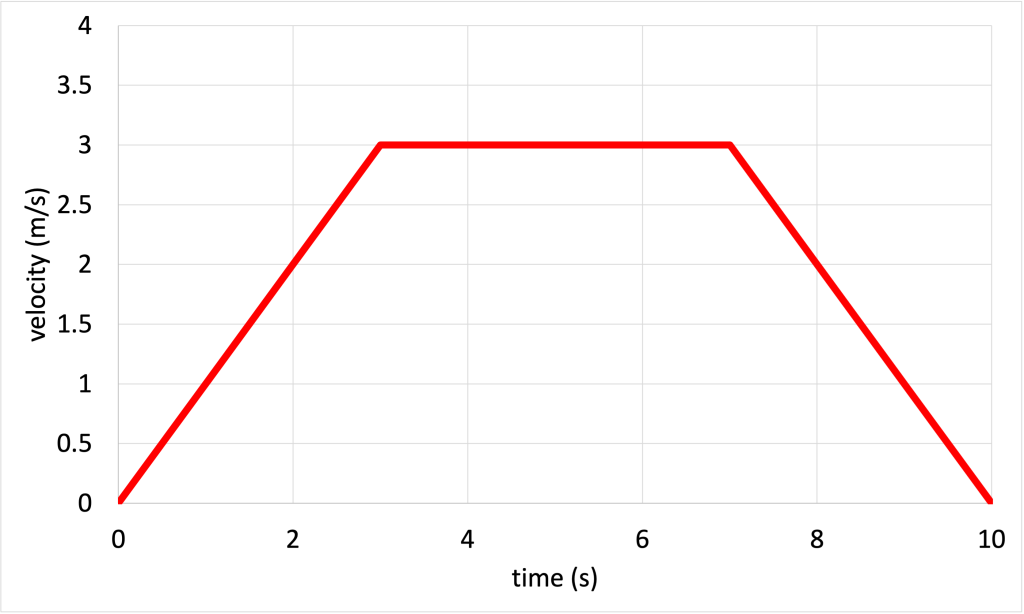
- For the first 3 seconds, speed up at an increasing rate in the positive direction. For the next 4 seconds, stop and stand still. Then, for the last 3 seconds, turn around and move back to the starting location at a constant speed.
- For the first 2 seconds, stop and stand still. For the next 3 seconds, speed up at a constant rate. For the next 2 seconds, continue to move at that constant fast pace. For the next second, slow down at a constant rate until stopped. Then, stand still for the final 2 seconds.
- The speed of the train is

- The final velocity of the car is

The distance traveled by the car is
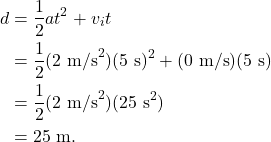
- First, calculate how long the object will be in the air between the start of its motion and the top of the trajectory. The instantaneous speed at the top of the trajectory is 0 m/s.
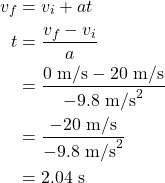
Now, use the distance equation to calculate the maximum height of the projectile.
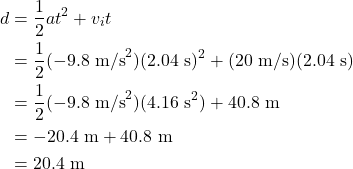
- First, use the distance equation to calculate the time the object is in free fall. If it starts at 0 m and moves down 40 m, its displacement is -40 m. The initial velocity can be assumed to be 0 m/s.
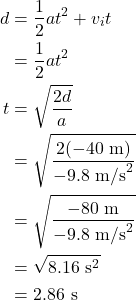
Now, use the velocity equation to calculate the final speed of the object before it hits the ground.

Chapter 4
Conceptual comprehension
- The BB will continue traveling in a straight-line after leaving the plastic tubing. It is only capable of traveling in a circular path when passing through the tubing because the tubing supplies a support force that changes the direction of the BB. This is shown in the video below.
Numerical analysis
- The net force acting on the object is

- The acceleration that will be created is

- The net force acting on the bicycle is 0 N, as the bicycle is moving at a constant velocity (acceleration is 0 m/s2).
- The net force acting on the spacecraft is
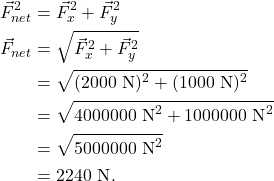
The acceleration of the spacecraft is equal to
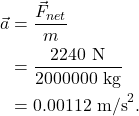
- The gravitational force acting on the object is

- The gravitational force acting on the person on the Moon is

Chapter 5
Conceptual comprehension
- Both the mosquito and the sports car experience identical magnitudes of force during the impact. This is because the forces are action-reaction pairs, which are equal in magnitude and opposite in direction.
Numerical analysis
- —
- Because the force that the rock exerts on the person during the kick and the force with which the person kicks the rock are action-reaction pairs, the magnitude of the force that the rock exerts on the person during the kick is 10 N.
- The acceleration of the person is
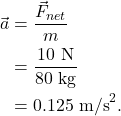
-
- The acceleration of the rock is

- —
- Because the force that the Earth exerts on the rocket is and the force that the rocket exerts on the Earth are action-reaction pairs, the magnitude of the force that the Earth exerts on the rocket is 350,000 N.
- The acceleration of the rocket is
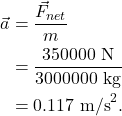
-
- The acceleration of the Earth is
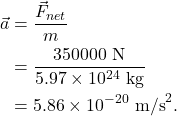
Chapter 6
Conceptual comprehension
- The unit of Ns is equal to kgm/s, as shown below.

Numerical analysis
- The momentum of the car is equal to

- The change in momentum of the soccer ball is equal to

- The impulse of the tennis ball is equal to
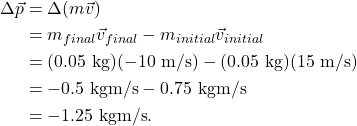
- —
- The initial momentum of the system is

-
- The final momentum of the system is also equal to 10,000 kgm/s, due to the law of conservation of momentum.
- The final velocity of both cars is equal to
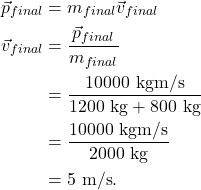
-
- This collision is perfectly inelastic because both cars travel together after the collision. It can also be shown that the collision is inelastic by comparing the initial and final kinetic energy of the system. Because the final KE is not equal to the initial KE, the collision must have been inelastic.
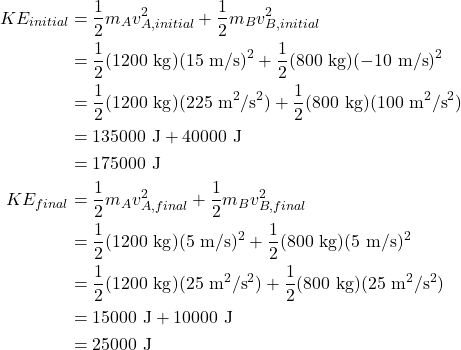
- —
- The initial momentum of the system is

-
- The final momentum of the system is also equal to 1.5 kgm/s, due to the law of conservation of momentum.
- The final velocity of both hockey pucks is equal to
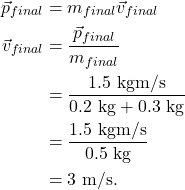
-
- This collision is perfectly inelastic because both hockey pucks travel together after the collision. It can also be shown that the collision is inelastic by comparing the initial and final kinetic energy of the system. Because the final KE is not equal to the initial KE, the collision must have been inelastic.
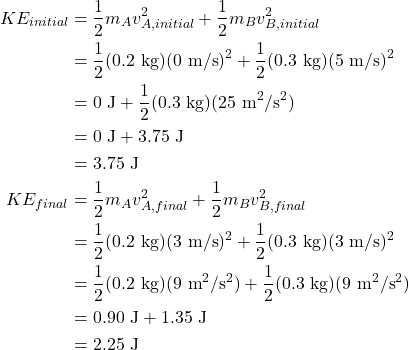
- —
- The initial momentum of the system is equal to

-
- The final momentum of the system is also equal to 15000 kgm/s, due to the law of conservation of momentum.
- The final velocity of car 2 is equal to
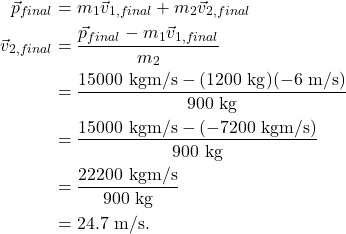
- The magnitude of the force of the collision is equal to
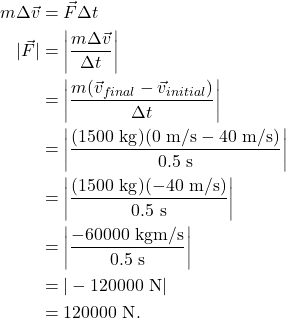
- The magnitude of the force of the collision is equal to

Chapter 7
Numerical analysis
- The gravitational potential energy of the object is equal to

- The gravitational potential energy of the object is equal to

- The gravitational potential energy of the spaceship is equal to

- The kinetic energy of the object is equal to
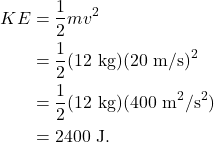
- The kinetic energy of the object is equal to

- The mechanical energy will be conserved throughout the motion of the object. Therefore the mechanical energy at the start is equal to the mechanical energy when the object is 5 m above the ground. The mechanical energy can be easily calculated at the start of the motion, and is equal to

The KE at the starting position is equal to zero, because the object is at rest at that point. When the object is 5 m above the ground, the KE is equal to
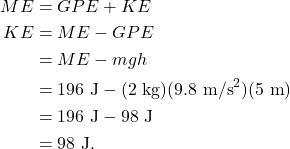
- The total mechanical energy will be conserved throughout the object’s motion. This can be used to calculate the final velocity of the object.

The initial velocity of the object is 0 m/s, and the final height of the object (at the instant before it hits the ground) is 0 m. This means that the ![]() and
and ![]() terms will both be equal to 0.
terms will both be equal to 0.
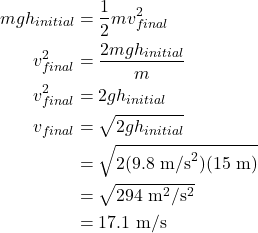
- The total mechanical energy will be conserved throughout the object’s motion. This can be used to calculate the final velocity of the object. As with the previous question, the initial velocity is 0 m/s and the final height is 0 m. This simplifies the equation that can be used to solve for the final velocity of the object.
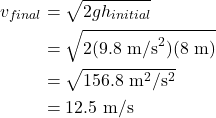
- The total mechanical energy will be conserved throughout the pendulum’s motion. This can be used to calculate the final velocity of the pendulum. As with the previous two questions, the velocity at the top of the swing is 0 m/s and the height at the bottom of the swing is 0 m. This simplifies the equation that can be used to solve for the final velocity of the pendulum.
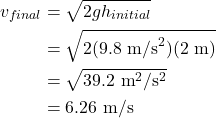
- The work done by the car engine is equal to

- The work done by the person on the sled is equal to

- The power output of the pulley system is equal to
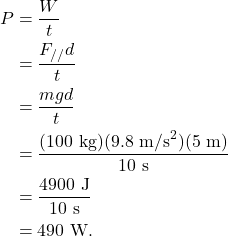
- The power applied to lift the object is equal to
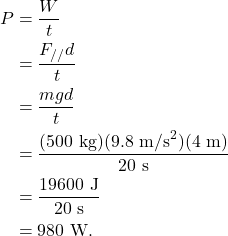
- Use conservation of work to solve for mechanical advantage. The mechanical advantage of the lever is equal to
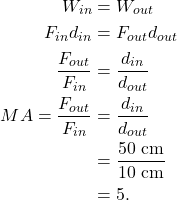
- —
- Use conservation of work to solve for the distance. The distance the object was moved upward is equal to
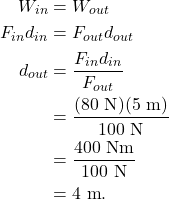
-
- The mechanical advantage of the inclined plane is equal to
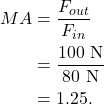
- The mechanical advantage of the pulley system is equal to 2.
- —
- The mechanical advantage of the lever is equal to

-
- The work input to the simple machine is equal to

-
- The workout output of the simple machine is equal to

-
- The efficiency of the lever is equal to

- —
- The work input to the pulley system is equal to

-
- The efficiency of the pulley system is equal to

Chapter 8
Conceptual comprehension
- Torque is equal to perpendicular force times distance from the axis of rotation. By maximizing the distance between the applied force (where the doorknob is positioned) and the axis of rotation (which is where the hinges are positioned), torque is maximized, which makes it easier to open the door.
Numerical analysis
- The rotational speed of the fan is equal to…
- …in rotations per minute:

-
- …in rotations per second:

-
- …in degrees per second:

-
- …in radians per second:

- The rotational speed of a long-playing vinyl record is equal to

The tangential velocity at the outer rim of the record is equal to
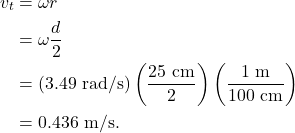
- The rotational speed of the bicycle wheel is equal to

The tangential velocity at the outer rim of the wheel is equal to

- When played from the outer rim, the rotational speed of the CD is equal to
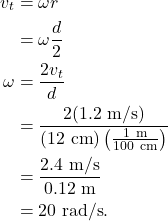
When played from a point halfway between the center and the outer rim, the rotational speed of the CD is equal to
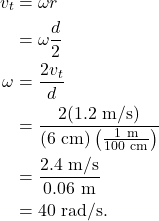
- The torque applied to the bolt is equal to

- To balance the see-saw, the person on the other end should sit at a distance equal to
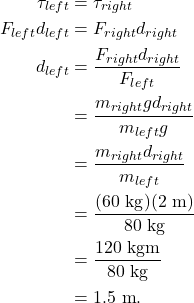
- The torque applied to the wrench is equal to

- —
- The centripetal force is equal to
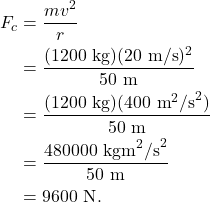
-
- The centripetal acceleration is equal to
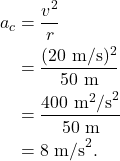
- —
- The centripetal force acting on the ball will be equal to 10 N. The centripetal force is supplied by (and is equal to) the tension in the string.
- The centripetal acceleration of the ball is equal to
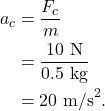
Chapter 9
Numerical analysis
- First, calculate the mass of the person, which is equal to
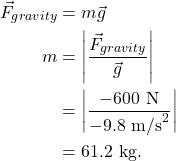
The apparent weight of the person while the elevator is accelerating upward is equal to
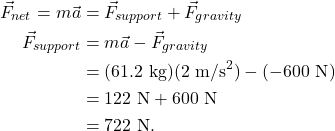
- The apparent weight at the top of the loop is 0 N. This can be deduced from the fact that the passengers experience a sensation of weightlessness.
- The gravitational force is equal to
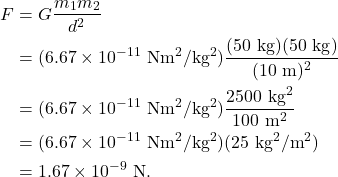
- The gravitational force is equal to
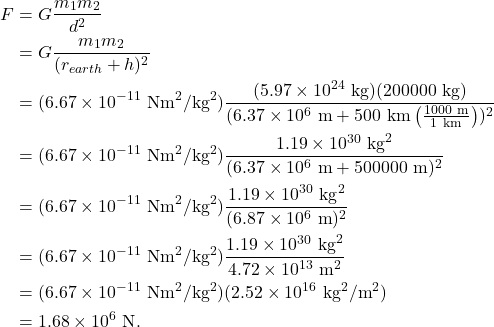
- The gravitational force is equal to
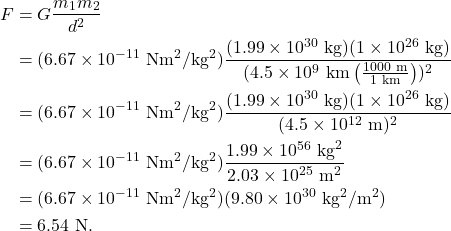
- The magnitude of the gravitational acceleration on the surface of Jupiter is equal to
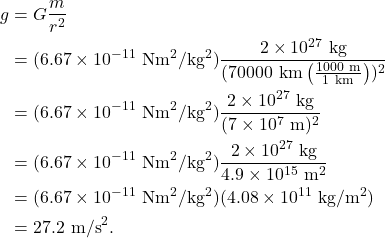
- The magnitude of the gravitational acceleration on the surface of Venus is equal to
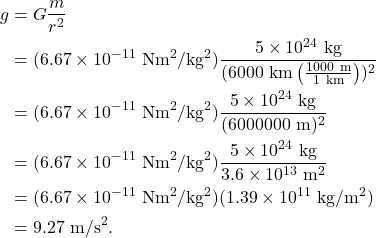
- The magnitude of the gravitational acceleration on the surface of Titan is equal to
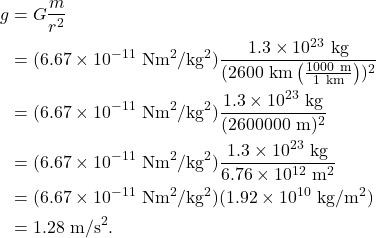
- The velocity of the satellite is equal to
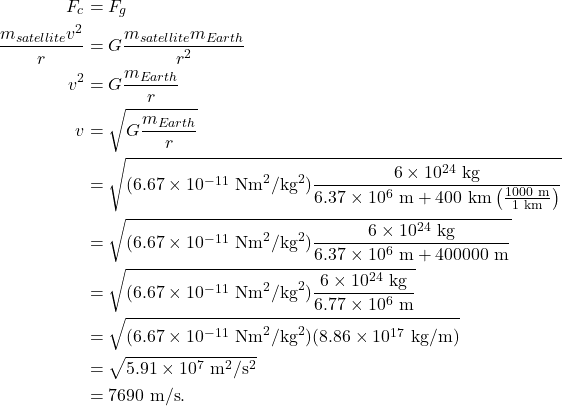
Chapter 10
Numerical analysis
- —
- The time it takes the ball to reach its maximum height is equal to
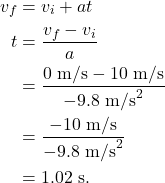
-
- The maximum height of the ball is equal to
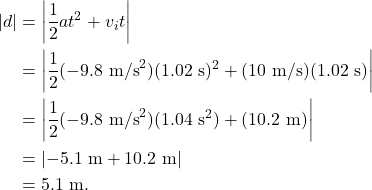
- —
- First, calculate the amount of time it takes the ball to travel before hitting the ground. This is limited by the vertical direction of travel. The initial component of the velocity in the vertical direction can be assumed to be zero.
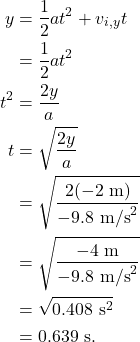
The distance that the ball travels horizontally before hitting the ground is equal to
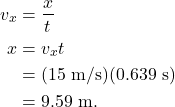
-
- The vertical speed of the ball immediately before impact is equal to
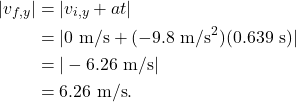
-
- The final horizontal speed of the ball is equal to the initial horizontal speed of the ball (15 m/s) because there is no force acting on the ball in the horizontal direction while it is in motion.
- The total magnitude of the ball’s velocity immediately before impact is equal to
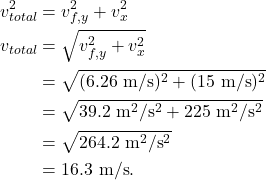
- —
- The distance the ball travels horizontally before hitting the ground is equal to
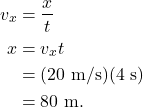
-
- The distance the ball travels vertically during that time is equal to
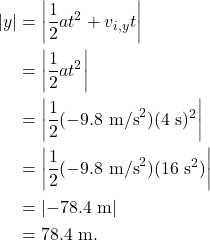
-
- The vertical speed of the ball immediately before impact is equal to
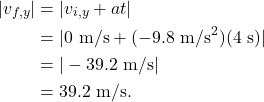
-
- The horizontal speed of the ball immediately before impact is equal to the initial horizontal speed, 20 m/s. This is because there is no force acting on the ball in the horizontal direction while it is in motion.
- The total magnitude of the ball’s velocity immediately before impact is equal to
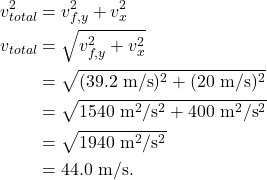
- The height of the bridge above the water’s surface is equal to
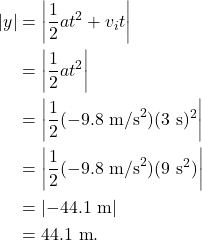
- —
- The time it takes for the rocket to hit the ground is equal to
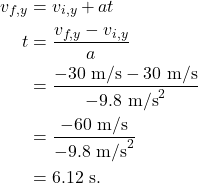
-
- The horizontal distance traveled by the rocket is equal to
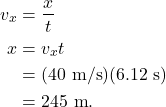
- The kinetic energy of the satellite is equal to
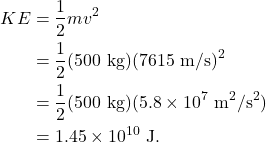
The gravitational potential energy of the satellite is equal to
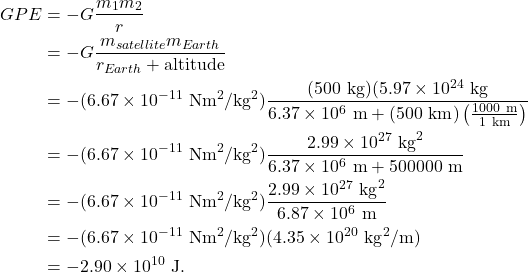
The total mechanical energy of the satellite is equal to

- First, it is necessary to calculate the velocity of the satellite. The satellite moves one circumference in a day. This tangential speed is equal to

The kinetic energy of the satellite is therefore equal to
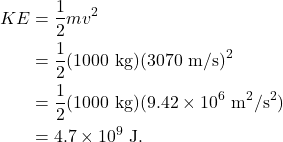
The gravitational potential energy of the satellite is equal to
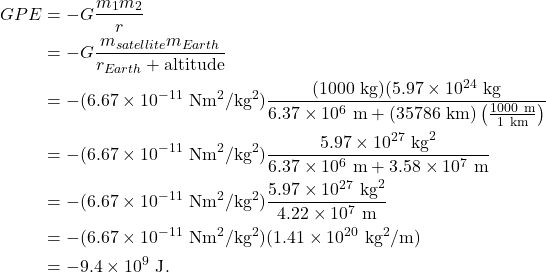
The total mechanical energy of the satellite is equal to

- —
- The gravitational potential energy of the satellite at an altitude of 200 km is equal to
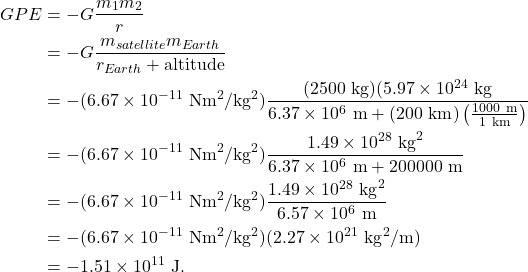
The gravitational potential energy when the satellite has an altitude of 400 km is equal to
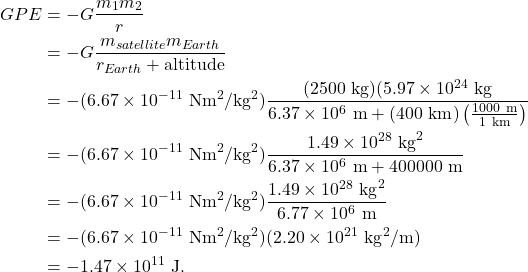
-
- Because mechanical energy is conserved, the change in mechanical energy of the satellite is equal to 0.
- Use conservation of mechanical energy to solve for the change in kinetic energy. The change in kinetic energy of the satellite is equal to

Chapter 11
Conceptual comprehension
- Information about each nucleus is given in the table below.
| nucleus | number of protons ( |
atomic mass number ( |
number of neutrons ( |
| 9 | 18 | 9 | |
| 11 | 20 | 9 | |
| 12 | 21 | 9 | |
| 14 | 23 | 9 |
All four nuclei contain the same number of neutrons.
Numerical analysis
- —
- Hydrogen contains 1 proton.
- Helium contains 2 protons.
- Carbon contains 6 protons.
- Oxygen contains 8 protons.
- Iron contains 26 protons.
- —
- The H2O molecule contains
 protons.
protons. - The CH4 molecule contains
 protons.
protons. - The N2 molecule contains
 protons.
protons. - The CO2 molecule contains
 protons.
protons. - The C6H12O6 molecule contains
 protons.
protons.
- The H2O molecule contains
- —
- Carbon-12 has 6 protons. Therefore, the number of neutrons is equal to

-
- Helium-4 has 2 protons. Therefore, the number of neutrons is equal to

-
- Oxygen-16 has 8 protons. Therefore, the number of neutrons is equal to

-
- Silicon-28 has 14 protons. Therefore, the number of neutrons is equal to

-
- Uranium-235 has 92 protons. Therefore, the number of neutrons is equal to

- —
 has 11 protons and a charge of +1. Therefore, the number of neutrons is equal to
has 11 protons and a charge of +1. Therefore, the number of neutrons is equal to

The number of electrons is equal to

-
 has 17 protons and a charge of -1. Therefore, the number of neutrons is equal to
has 17 protons and a charge of -1. Therefore, the number of neutrons is equal to

The number of electrons is equal to

-
 has 12 protons and a charge of +2. Therefore, the number of neutrons is equal to
has 12 protons and a charge of +2. Therefore, the number of neutrons is equal to

The number of electrons is equal to

-
 has 35 protons and a charge of -1. Therefore, the number of neutrons is equal to
has 35 protons and a charge of -1. Therefore, the number of neutrons is equal to

The number of electrons is equal to

Chapter 12
Numerical analysis
- The density of the object is equal to
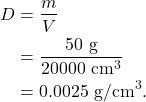
Using a unit of kg/m3, the volume is equal to

- The density of the stone is equal to
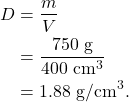
Using a unit of kg/m3, the volume is equal to
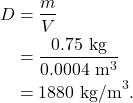
- The density of the wooden cube is equal to
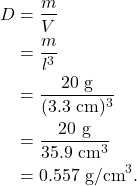
Using a unit of kg/m3, the volume is equal to
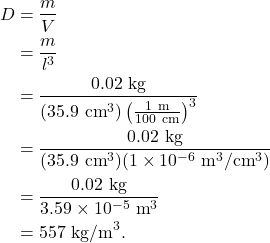
- The distance that the spring will stretch is equal to
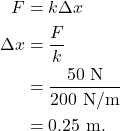
- The force applied to the spring must be equal to

- The spring constant of the spring is equal to
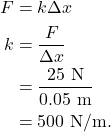
- Each spring will stretch a distance that is equal to
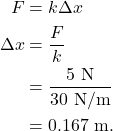
Therefore, the total distance that both springs stretch will be equal to

- Each spring only experiences 2.5 N of force. Therefore, the distance both springs will stretch is equal to
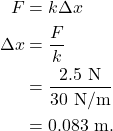
- —
- The surface area of the cube is equal to
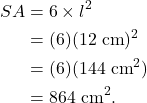
-
- The volume of the cube is equal to

-
- The surface area to volume ratio of the cube is equal to

Chapter 13
Conceptual comprehension
- Buoyant force is directly proportional to both the density of the fluid and the volume of displaced fluid. Both spheres are in the same fluid, so this variable will not play a role in which sphere (if any) experiences a greater buoyant force. The sphere that sinks displaces more fluid than the sphere that floats. Therefore, the sphere that sinks experiences the greater buoyant force.
Numerical analysis
- The pressure exerted on the floor by the box is equal to
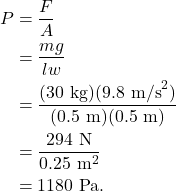
- —
- The pressure exerted by the book on the table is equal to
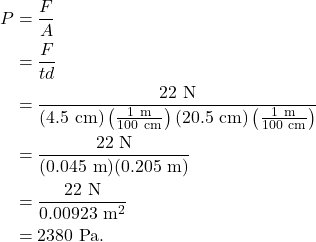
-
- The pressure exerted by the book on the table is equal to
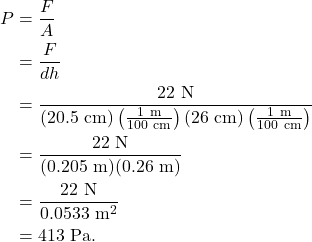
- —
- The pressure exerted by the person on the floor while barefoot is equal to
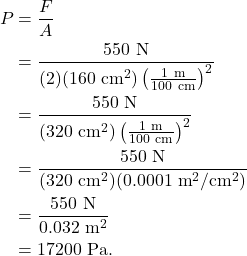
-
- The pressure exerted by the person on the floor while wearing high heels (and fully balanced on their heels) is equal to
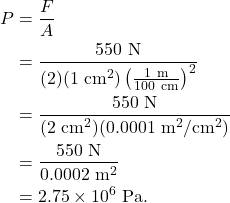
- The total pressure exerted by all four tires on the road is equal to
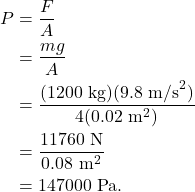
- The pressure at the bottom of the pool due to the weight of the water is equal to

- The pressure on the submarine due to the weight of the water above it is equal to

- The buoyant force acting on the cube is equal to

- The buoyant force acting on the wooden block is equal to

- —
- The weight of the ship is equal to

-
- The weight of the liquid that must be displaced to cause the ship to float is equal to the ship’s weight, which is

- The volume of displaced freshwater is equal to
- The weight of the liquid that must be displaced to cause the ship to float is equal to the ship’s weight, which is
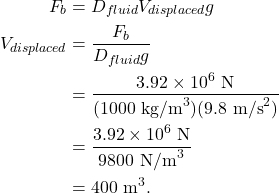
-
- The volume of displaced seawater is equal to
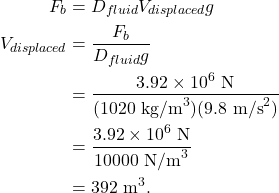
- The pressure exerted on the fluid is equal to
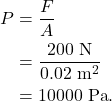
- The force exerted by the large piston is equal to
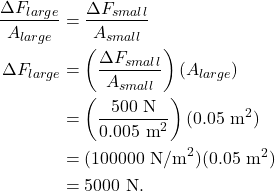
- The force exerted by the large piston on the car is equal to
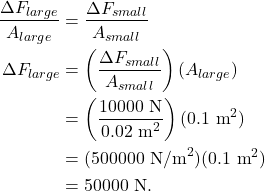
Chapter 14
Numerical analysis
- The new volume of the gas is equal to
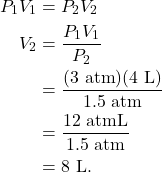
- The new volume of the gas is equal to
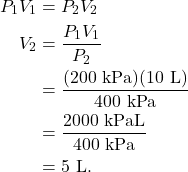
- The pressure of the gas is equal to

- The final volume of the weather balloon is equal to
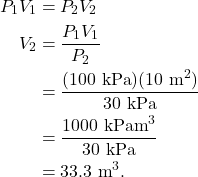
- The buoyant force acting on the helium balloon is equal to

Chapter 15
Numerical analysis
- —
- The temperature is equal to

-
- The temperature is equal to

- —
- The temperature is equal to
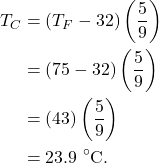
-
- The temperature is equal to

- —
- The temperature is equal to

-
- The temperature is equal to

- The amount of heat required to change the temperature of the water is equal to
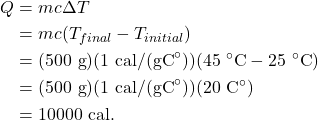
- The amount of heat required to change the temperature of the aluminum is equal to
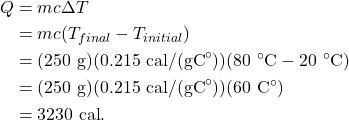
- The amount of heat required to change the temperature of the lead is equal to

- The amount of heat required to heat the water and the copper kettle is equal to
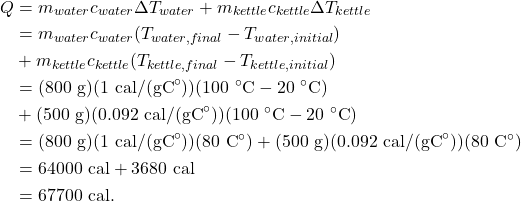
- Because both substances have equal masses and have the same specific heat capacity, the final temperature will be an average of each temperature, which is equal to
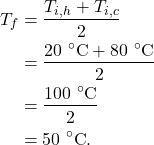
- The final temperature is equal to
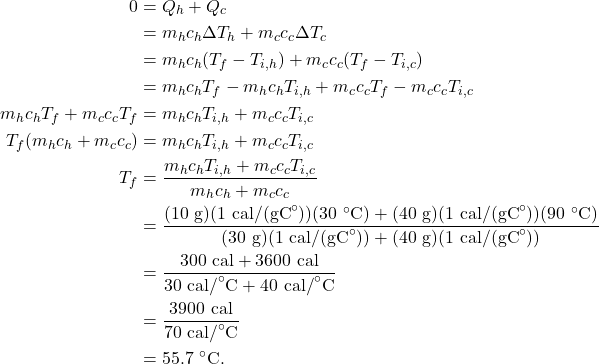
- The final temperature is equal to

- The final temperature is equal to
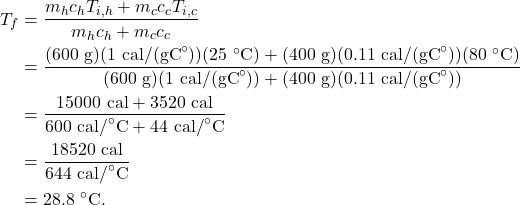
Chapter 16
Numerical analysis
- The area of the solar panels is equal to
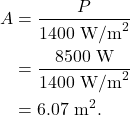
- The area of the solar panels is equal to

- The efficiency of the solar panels is equal to

- The initial difference between the temperature of the cookies and the surroundings is equal to
![]()
-
- The new difference between the temperature of the cookies and the surroundings is equal to
![]()
Because this is one half the initial temperature difference, the new rate of cooling will also be one half the initial rate of cooling, or 2 oC/min.
-
- The new difference between the temperature of the cookies and the surroundings is equal to
![]()
Because this is one quarter the initial temperature difference, the new rate of cooling will also be one quarter the initial rate of cooling, or 1 oC/min.
-
- The new difference between the temperature of the cookies and the surroundings is equal to
![]()
Because this is one eighth the initial temperature difference, the new rate of cooling will also be one eighth the initial rate of cooling, or 0.5 oC/min.
Chapter 17
Numerical analysis
- The amount of heat required to heat the ice and melt it is equal to

- The amount of heat required to boil the water is equal to

- The amount of heat required to melt the lead is equal to

- —
- The freezing/melting point of the substance is -100 oC.
- The condensation/vaporization point of the substance is 50 oC.
- The latent heat of fusion of the substance is 50 cal/g.
- The latent heat of vaporization of the substance is 200 cal/g.
- The specific heat capacity of the solid form of the substance is equal to

-
- The specific heat capacity of the liquid form of the substance is equal to
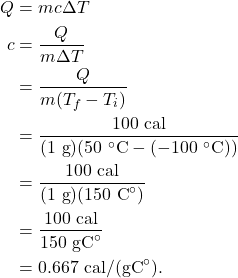
-
- The specific heat capacity of the gaseous form of the substance is equal to
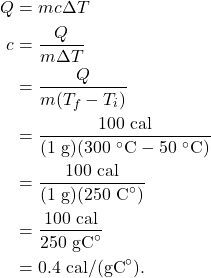
Chapter 18
Numerical analysis
- The change in internal energy of the gas is equal to

- The change in internal energy of the system is equal to

- The heat added to the gas is equal to

- The Carnot efficiency of the engine is equal to
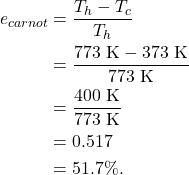
- The Carnot efficiency of the engine is equal to
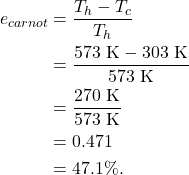
- The Carnot coefficient of performance of the refrigerator is equal to
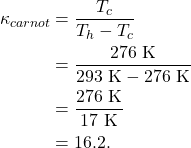
- The Carnot efficiency of the engine is equal to
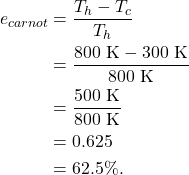
- —
- The total number of states is equal to 16.
- Two of the 16 states are highly ordered, which is equal to 12.5%.
- —
- The total number of states is equal to 36.
- Six of the states are highly ordered, which is equal to 16.7%.
- —
- The total number of states is 216.
- Six of the states are highly ordered, which is equal to 2.78%.
Chapter 19
Numerical analysis
- —
- The amplitude of the wave is equal to 4. The unit is arbitrary.
- The wavelength of the wave is equal to 2 m.
- The wave speed of the wave is equal to

- The frequency of the wave is equal to

- The frequency of the wave is equal to

- The frequency of the wave is equal to

- The wave speed of the wave is equal to

- —
- The frequency of the second harmonic is equal to

-
- The frequency of the third harmonic is equal to

- The frequency of the first harmonic is equal to

- The scenario is depicted in Figure C.14.

The length of the rope is equal to 1 m.
- —
- A wave with three nodes represents the second harmonic.
- The wavelength of the wave is equal to 30 cm.
- The frequency of the wave is equal to
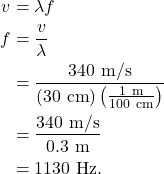
- —
- A wave with five antinodes represents the fifth harmonic.
- The scenario is depicted in Figure C.15.
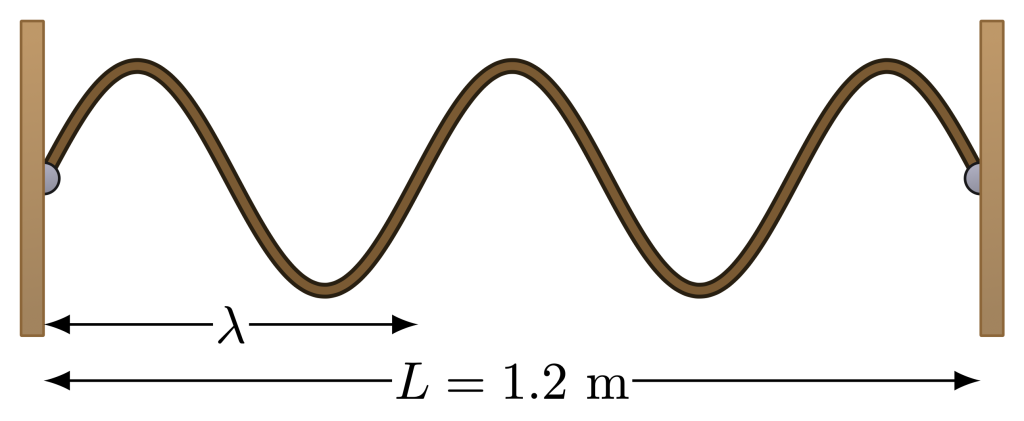
There are 2.5 wavelengths between the two fixed ends. Therefore, the wavelength of this harmonic is equal to

-
- The frequency of the wave is equal to

Chapter 20
Numerical analysis
- —
- The speed of sound at this temperature is equal to

-
- The speed of sound at this temperature is equal to
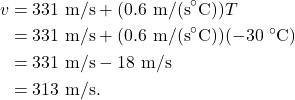
-
- The speed of sound at this temperature is equal to

- The temperature of the lab is equal to
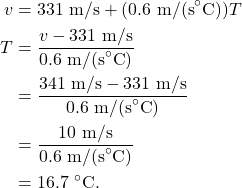
- The temperature of the oven is equal to
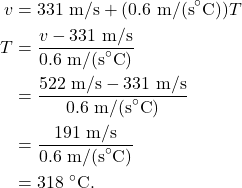
- The beat frequency is equal to

- The beat frequency is equal to

- The two possible frequencies are equal to
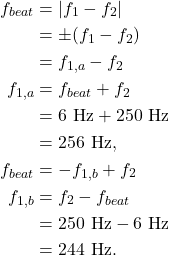
Chapter 21
Conceptual comprehension
- The sound wave that produced the given waveform is most likely a musical sound. This is due to the fact that the Fourier analysis exhibits mostly discrete frequencies.
- The sound wave that produced the given waveform is most likely a noisy sound. This is due to the fact that the Fourier analysis exhibits mostly random frequencies.
Numerical analysis
- The frequency of the peak value is equal to
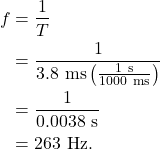
- The frequency of the peak value is equal to
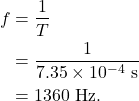
- The sound intensity in dB is equal to
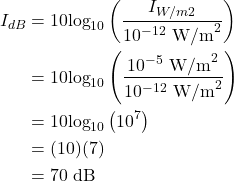
- —
- A 50 dB sound is 10x more intense than a 40 dB sound.
- A 50 dB sound is 100x more intense than a 30 dB sound.
- A 50 dB sound is 1,000x more intense than a 20 dB sound.
- A 50 dB sound is 10,000x more intense than a 10 dB sound.
- The new intensity is 30 dB more intense than the original sound, giving it a total intensity of 110 dB.
Chapter 22
Numerical analysis
- —
- Charge A would move to the right.
- Charge B would move to the left.
- The magnitude of the force between the two charges is equal to
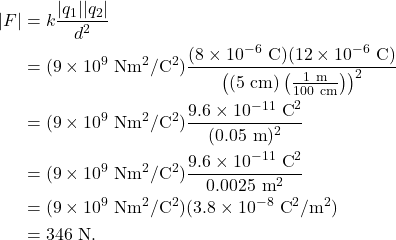
-
- Charge A would move to the left.
- Charge B would move to the right.
- The magnitude of the electrostatic force is equal to

- The magnitudes of each charge due to the other two charges are equal to
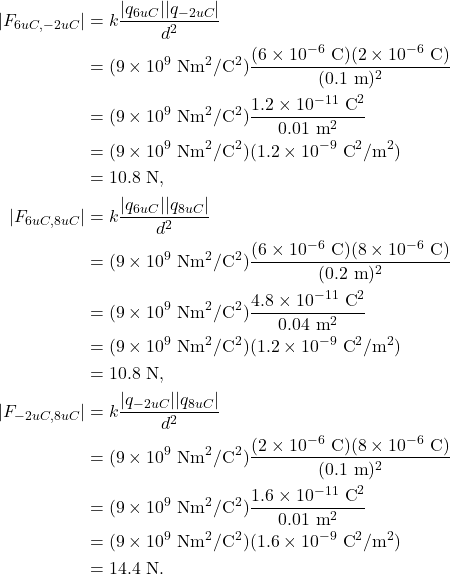
-
- The net force acting on the +6 μC charge due to the other two charges is equal to

-
- The net force acting on the -2 μC charge due to the other two charges is equal to

-
- The net force acting on the +8 μC charge due to the other two charges is equal to

Chapter 23
Conceptual comprehension
- —
- Light bulbs A and B will both have the same amount of brightness. This is because they both have the equal amounts of voltage (because both light bulbs are identical, they will each share one half of the total voltage of the source) and equal amounts of current (because the circuit is a series circuit, the amount of current is the same at all points in the circuit), therefore they will have equal power and equal brightness.
- Light bulbs C and D will both have the same amount of brightness. This is because they both have the equal amounts of voltage (because the circuit is a parallel circuit, both light bulbs share the same voltage level as the voltage source) and equal amounts of current (because both light bulbs are identical, they have the same value of
 ), therefore they will have equal power and equal brightness.
), therefore they will have equal power and equal brightness. - The series light bulbs will be dimmer than the parallel light bulbs. This is because each series light bulb has half the voltage as each parallel light bulb, and half the current as each parallel light bulb. Therefore, each series light bulb has one quarter the power as each parallel light bulb.
- In a series circuit with three light bulbs, if one light bulb burns out, the other two light bulbs will turn off. This is because current can no longer flow through the circuit. In a circuit with three light bulbs wired in parallel, if one light bulb burns out, the other two light bulbs will not be affected. This is because only the path of the burnt out light bulb is effectively removed from the circuit, leaving the other two paths unaffected.
- When you add more light bulbs to a series circuit, the brightness of all of the light bulbs will become dimmer (although each individual light bulb will still have the same amount of brightness as the others, if they are all identical). When you add more light bulbs to a parallel circuit, the brightness of all of the light bulbs will be unaffected. This is because each branch will have the same voltage as the source, and the same value of
 , leaving the power in each branch unaffected by the number of branches.
, leaving the power in each branch unaffected by the number of branches.
Numerical analysis
- The current through the resistor is equal to

- The resistance of the circuit elements is equal to

- The voltage is equal to

- The power consumed by the device is equal to

- The current through the light bulb is equal to

- The power consumed by the resistor is equal to

- —
- The total resistance of the circuit is equal to

While not explicitly asked for, it is also useful to calculate the current through both resistors, which is equal to
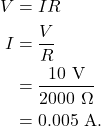
-
- The power consumed by the 800 ohm resistor is equal to
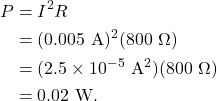
-
- The power consumed by the 1200 ohm resistor is equal to
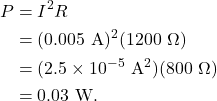
- —
- The total resistance of the circuit is equal to

While not explicitly asked for, it is also useful to calculate the current through the three resistors, which is equal to
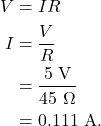
-
- The power consumed by the 10 ohm resistor is equal to
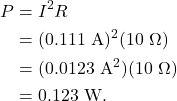
-
- The power consumed by the 15 ohm resistor is equal to
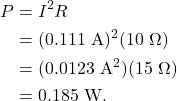
-
- The power consumed by the 20 ohm resistor is equal to
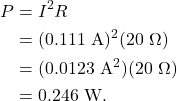
- —
- The total current will be distributed equally through each of the two branches. Therefore, each resistor will have a current of 0.05 A.
- The power consumed by each resistor is equal to

Chapter 24
Conceptual comprehension
- Because the painted end of a compass needle is a north magnetic pole, and the painted end of a compass needle repels from the south pole of the Earth, the south pole of the Earth is a north magnetic pole. Like poles repel.
Chapter 25
Conceptual comprehension
- This is a step-up transformer, due to the fact that the secondary contains more windings than the primary.
- This is a step-down transformer, due to the fact that the secondary contains less windings than the primary.
Numerical analysis
- The number of turns in the secondary coil is equal to
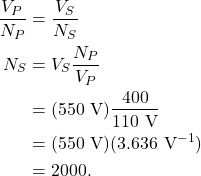
- The number of turns in the secondary coil is equal to
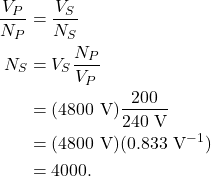
- The number of turns in the primary coil is equal to
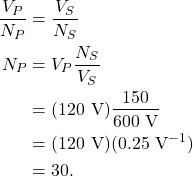
- The number of turns in the secondary coil is equal to
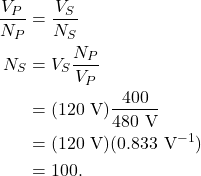
- The number of turns in the primary coil is equal to
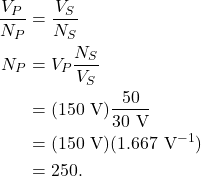
- The power consumed by each coil is equal to

- The current through the secondary circuit is equal to
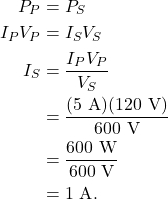
- The current through the primary circuit is equal to
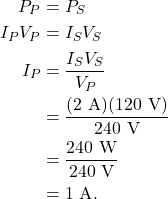
Chapter 26
Conceptual comprehension
- Light is capable of traveling from the Sun, through the vacuum of space, to the Earth. If light required a medium in which to travel, we would not be able to experience the Sun’s light on Earth.
Numerical analysis
- —
- The amount of time it takes for an electromagnetic wave to travel from the Earth to the Moon is equal to
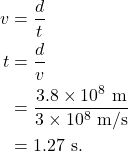
-
- The amount of time it takes for an electromagnetic wave to travel from the Earth to Mars is equal to
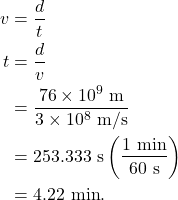
-
- The amount of time it takes for an electromagnetic wave to travel from the Earth to Voyager 1 is equal to
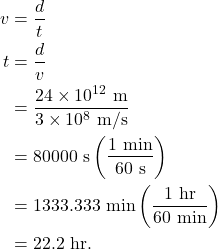
- The wavelength of the electromagnetic wave is equal to
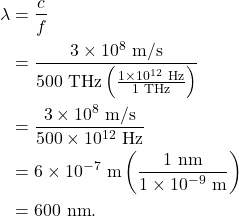
- The frequency of the electromagnetic wave is equal to
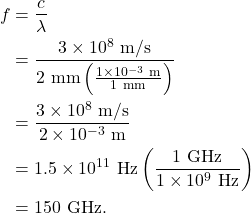
- The wavelength of the WDCB radio waves is equal to
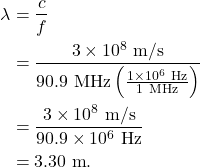
- The frequency of that particular wavelength of red light is equal to
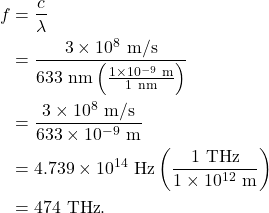
Chapter 27
Conceptual comprehension
- The color yellow will appear when shining equal intensities of red and green light onto a white surface. This is because yellow is the secondary color generated when red and green are mixed with color addition.
- To generate colors such as orange or purple, use color addition to mix unequal intensities of red, green, and blue light until the desired effect is achieved. You can try this yourself using the PhET Color Vision simulation.
- If you look through both a red and blue filter simultaneously, no light should reach your eyes and what you see should appear black. This is because the red filter will absorb (block) green and blue light, allowing only red light to transmit through. Then, the blue filter will absorb (block) that red light. This is depicted in Figure C.16.
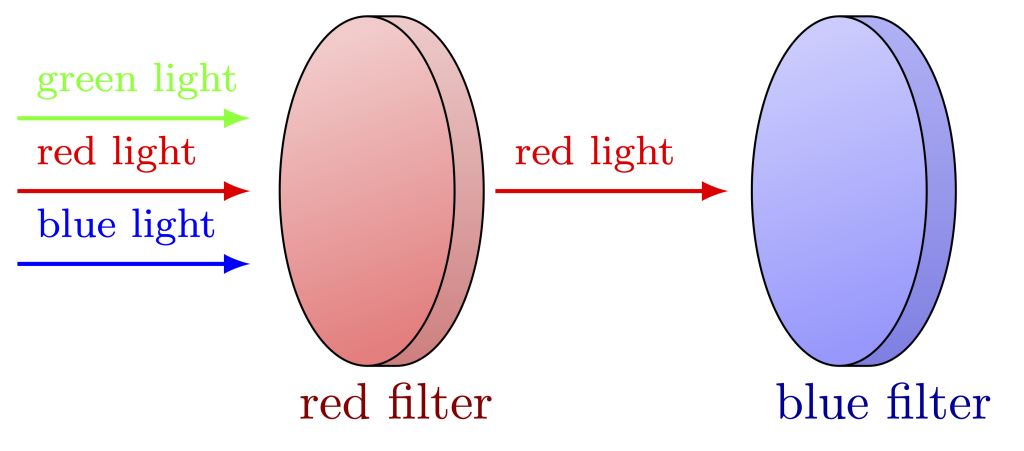
- When white light is shone through a green filter, only green light will transmit through. The green filter will absorb red and blue light. If other colors of light are shone through a green filter, only the green components of that light will transmit. If there are no green components (such as with red or blue light), then no light will be transmitted through the green filter. You can try this yourself using the PhET Color Vision simulation. You can also try this using the Physics Classroom Filtering Away simulation.
- When white light is shone onto a cyan object, the object will appear cyan. This is because the object will absorb red light and reflect green and blue (cyan) light back to the viewer, explained by the concept of color subtraction. If red light is shone onto the cyan object, all of that red light will be absorbed, causing the object to appear black to the viewer. If green light is shone onto the cyan object, that green light will be reflected, causing the object to appear green. You can try this yourself using the Physics Classroom Stage Lighting simulation (if you want to see the effect on a cyan object, click on the stage repeatedly until the glass of water appears).
- A blue object will appear to be black when illuminated with red light. This is because the blue object will absorb blue and green light and only reflect blue light, none of which is present in a red light source. You can try this yourself using the Physics Classroom Stage Lighting simulation (if you want to see the effect on a blue object, click on the stage repeatedly until the blueberry appears).
Chapter 30
Conceptual comprehension
- The color of a star relates to its temperature due to incandescence. A hot star will appear more blue than a red star.
Numerical analysis
- The wavelength of this light wave is equal to
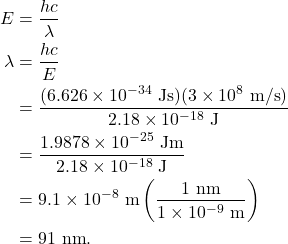
This corresponds to a frequency of

- —
- There are 15 total electron transitions. This is depicted in Figure C.17.
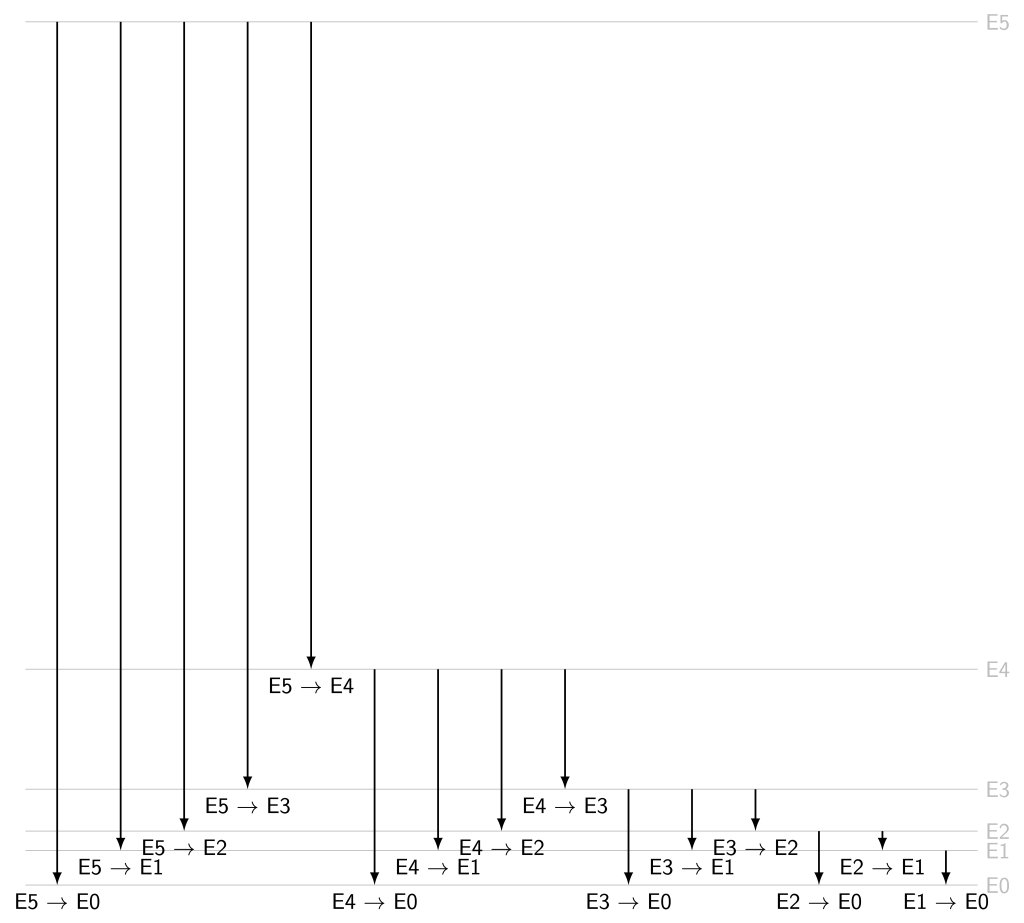
-
- The amount of energy required to jump from the ground state (E0) to E2 is equal to

-
- The wavelength corresponding to the transition between the ground state (E0) to E2 is equal to
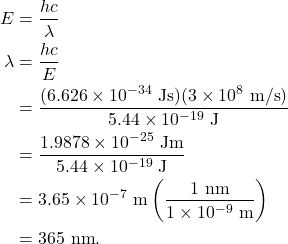
-
- The largest energy transition is the jump between levels E5 and E0, which corresponds to an energy of

-
- The wavelength corresponding to the largest energy transition is equal to

-
- The smallest energy transition is the jump between levels E2 and E1, which corresponds to an energy of

-
- The wavelength corresponding to the largest energy transition is equal to
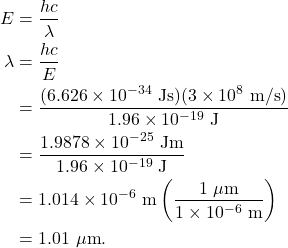
Chapter 31
Numerical analysis
- The velocity of the Olympic sprinter is equal to
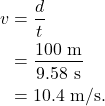
The wavelength of the Olympic sprinter is therefore equal to
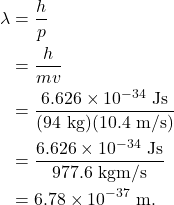
- The wavelength of the cyclist and her bicycle is equal to
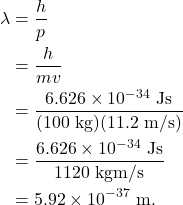
- The wavelength of the ice hockey puck is equal to
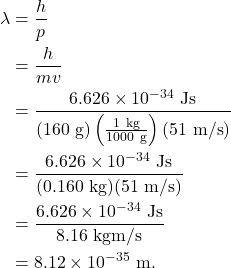
- The wavelength of the electron is equal to

- The wavelength of the neutron is equal to
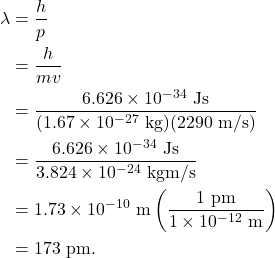
- The wavelength of the helium atom is equal to
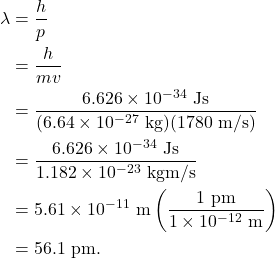
- The wavelength of the sodium atom is equal to
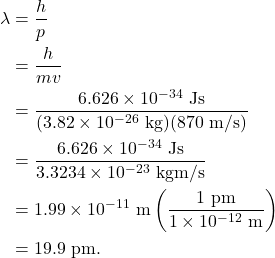
Chapter 32
Numerical analysis
- The wave function squared is depicted in Figure C.18.
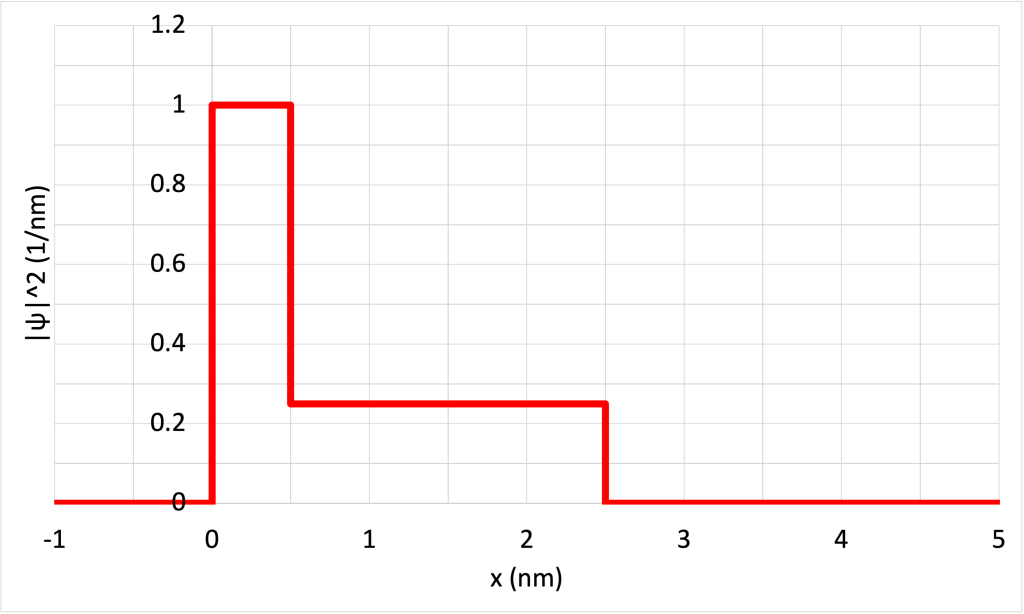
-
- The probability of finding the particle in the range of 0 < x < 0.5 nm is equal to

-
- The probability of finding the particle in the range of 0.5 nm < x < 2.5 nm is equal to

-
- The probability of finding the particle in the range of 1 nm < x < 2 nm is equal to
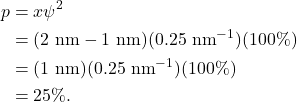
-
- The probability of finding the particle in the range of x < 0 nm is equal to 0%.
- The wave function squared is depicted in Figure C.19.

-
- The probability of finding the particle in the range of 0 < x < 1 nm is equal to

-
- The probability of finding the particle in the range of 1 nm < x < 2 nm is equal to

-
- The probability of finding the particle in the range of 3 nm < x < 4 nm is equal to

-
- The probability of finding the particle in the range of 1.5 nm < x < 3.5 nm is equal to
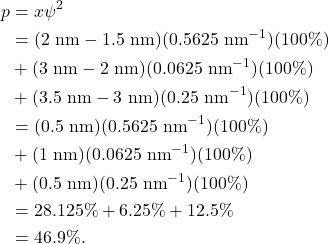
-
- The probability of finding the particle in the range of 0 < x < 5 nm is equal to

- —
- The probability is now calculated using the area of a triangle due to the shape of the wave function squared. The value of
 is equal to the “height” of the value of
is equal to the “height” of the value of  . The probability of finding the particle in the range of 0 < x < 1 nm is equal to
. The probability of finding the particle in the range of 0 < x < 1 nm is equal to
- The probability is now calculated using the area of a triangle due to the shape of the wave function squared. The value of
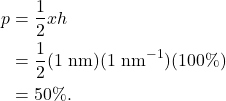
-
- The probability of finding the particle in the range of 1 nm < x < 2 nm is equal to
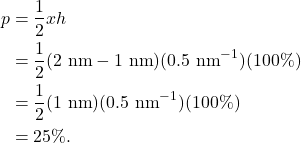
-
- The probability of finding the particle in the range of 0.5 < x < 2 nm is equal to
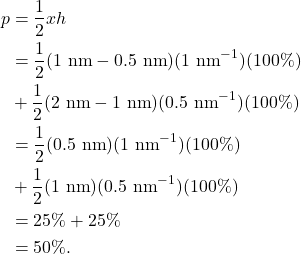
-
- The probability of finding the particle in the range of 1.5 < x < 3 nm is equal to 50% (which is the probability of finding the the particle between the range of 1 nm and 3 nm) minus the probability of finding the particle in the range of 1 nm and 1.5 nm. This is equal to
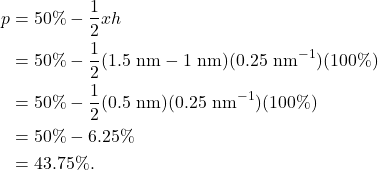
-
- The probability of finding the particle in the range of x > 3 nm is equal to 0%.
Chapter 33
Conceptual comprehension
- Americium-241 must undergo beta-minus decay to become plutonium. This is the only decay process by which a nucleus can gain a proton. This particular decay process can be summarized by the equation
![]()
- After any given interval of time, more undecayed nickel-63 will be present compared to undecayed nickel-56. This is because nickel-63 has a much longer half-life than nickel-56, so it will take much longer for the sample to decay.
Numerical analysis
- The number of nucleons in the new nucleus is equal to

The number of protons in the new nucleus is equal to

This new nucleus corresponds to neptunium-237.
- The number of nucleons in the new nucleus is equal to

The number of protons in the new nucleus is equal to

This new nucleus corresponds to radon-219.
- The number of nucleons in the new nucleus is equal to 14, as beta-minus decay will not change the number of nucleons in a nucleus. The number of protons in the new nucleus is equal to

This new nucleus corresponds to nitrogen-14.
- —
- Polonium-218 undergoes beta-minus decay to become astatine-218, which can be summarized by the decay equation
![]()
-
- Bismuth-210 undergoes alpha decay to become thallium-214, which can be summarized by the decay equation
![]()
-
- Aluminum-26 undergoes beta-plus decay to become magnesium-26, which can be summarized by the decay equation
![]()
-
- Nitrogen-11 undergoes proton emission to become carbon-10, which can be summarized by the decay equation
![]()
- Lead-206 is the result of the decay of uranium-234. This is because only alpha decay will change the atomic mass number of a nucleus. Alpha decay removes four nucleons from a nucleus. If six alpha decays occur, the atomic mass number becomes 210 (lead-210 is not a stable isotope of lead, nor was it one of the options given in the question). If seven alpha decays occur, the atomic mass number becomes 206.
- As stated in the question above, seven alpha decays are necessary to obtain lead-206. However, if only alpha decays occur, the resulting atomic number will be 78, which corresponds to platinum. To obtain an atomic number of 82 (corresponding to lead), 4 beta-minus decays must also occur in the decay chain.
- The number of half-lives that have elapsed after 22.8 days is equal to
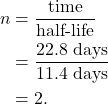
Therefore, the amount of undecayed radium-223 left after this period of time is equal to
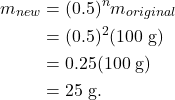
The number of half-lives that have elapsed after 45.6 days is equal to
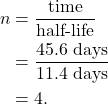
Therefore, the amount of undecayed radium-223 left after this period of time is equal to
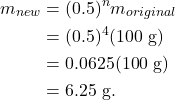
- Two half-lives have elapsed to result in only 25% undecayed element remaining after 8 days. This means that a single half-life is equal to 4 days.
- In one year, the flight crew can fly a number of hours equal to
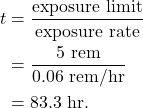
Chapter 34
Conceptual comprehension
- In a commercial nuclear fission reactor that generates electricity, the most desirable neutron multiplication number is equal to one. This is to prevent the reaction from dying out (which will happen if k is less than one) or from growing out of bounds and causing an explosion (which will happen if k is greater than one).
- Two neutrons will be generated in this reaction. This is the only outcome consistent with conservation of nucleons. The reaction equation can be expressed as
![]()
- The atomic mass number of the zirconium isotope involved in this reaction is equal to 97. This is the only outcome consistent with conservation of nucleons. The reaction equation can be expressed as
![]()
Numerical analysis
- The total number of fission events occurring during the 6th cycle is equal to

The total number of fissions that have taken place since the start of the reaction is equal to
![]()
- The amount of time it will take for 1023 fission events to occur is equal to

- It will take 9 cycles to create 1023 fission events when k=2. This result can be demonstrated in the table below.
| cycle number | 0 | 1 | 2 | 3 | 4 | 5 | 6 | 7 | 8 | 9 |
| fission events occurring | 1 | 2 | 4 | 8 | 16 | 32 | 64 | 128 | 256 | 512 |
| total fission events | 1 | 3 | 7 | 15 | 31 | 63 | 127 | 255 | 511 | 1023 |
Therefore, the amount of time it takes for 1023 fission reactions to occur is equal to

This is

times faster than the critical reaction.
- The rate at which mass is converted to energy is equal to mass divided by time. This rate is equal to
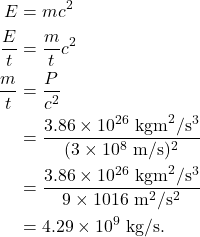
- The final mass of all byproducts is equal to

Therefore, the energy released in this reaction is equal to
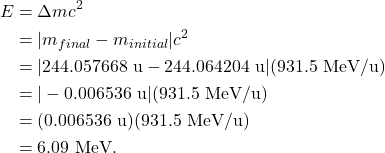
- The initial mass is equal to

The final mass is equal to

Therefore, the energy released in this reaction is equal to
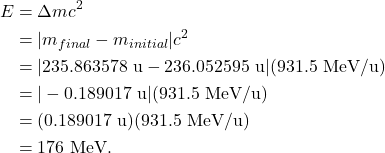
- —
- The initial mass is equal to

The final mass is equal to

Therefore, the energy released in this reaction is equal to
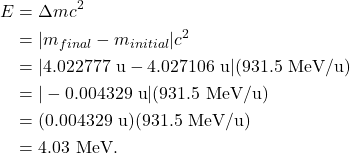
-
- The initial mass is equal to

The final mass is equal to

Therefore, the energy released in this reaction is equal to
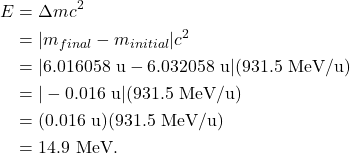
- The average nuclear binding energy per nucleon for nickel-62 is 8.79 MeV. Therefore, the amount of energy it takes to disassemble a nickel-62 nucleus into its individual protons and neutrons is equal to

- The average mass per nucleon of a carbon-12 nucleus is equal to 1 u. (This is the definition of 1 u.)
- First, the number of atoms of carbon-12 in 12 mg must be calculated. The atomic mass is a measure of how much mass one mole of a particular type of atom will have if that mass is measured in grams. Because the atomic mass of carbon-12 is 12, this means that one mole of carbon-12 atoms has a mass of 12 grams. 12 mg of carbon-12 represents one thousandth of a mole of atoms.

The amount of energy required to disassociate a single carbon-12 atom is equal to the difference between the atomic mass of carbon-12 and the mass of 6 protons and 6 neutrons. This is equal to

Therefore, the energy released by ![]() atoms of carbon-12 is equal to
atoms of carbon-12 is equal to
![]()
Converted to a unit of joules, this represents

The amount of gasoline required to supply this energy is equal to


